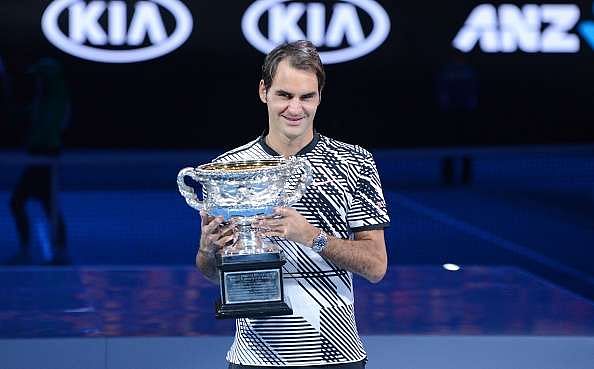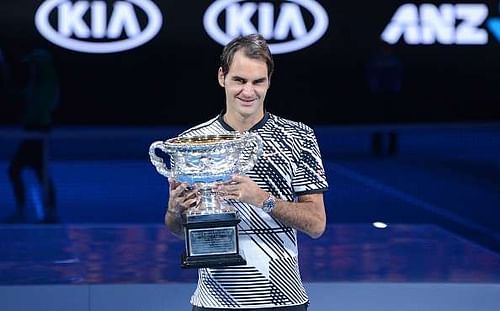
Are you even human, Roger Federer?

Roger Federer posing with the 2017 Australian Open trophy
Let’s talk about Roger Federer.
Here is a man who is 35 years old, an age at which most tennis champions are well into retired life. Does that make him love the game any less? You’d be bat-shit crazy to think that it would.
Here is a man who had recently been laid low by a debilitating knee injury, which necessitated a six-month layoff and ended his long-cherished dream of representing Switzerland at one more edition of the Olympics. Few events could be as morale-shattering as that, and yet the thought of quitting didn’t cross his mind a single time.
Here is a man who has a near-perfect family – a wonderfully supportive wife and two sets of adorable twins. It’s hard to not go ‘Awww’ every time the camera focuses on them, they are so impossibly cute. With that to go back home to, surely the on-court losses don’t hurt as much as they do for the rest of the tour? Two words: Shut up.
Here is a man who has won practically everything there is to win in the sport of tennis, and is undisputedly the most successful male player of all time. Shouldn’t that make him a little less enthusiastic about the day-to-day grind of the ATP tour? Maybe skip the claycourt season every once in a while? He’d laugh in your face if you so much as suggested that.
Here is a man who has been slowed down by Father Time, and whose movement and foot-speed are nowhere near as explosive as his younger, fitter rivals’. Lesser mortals would use that as an excuse to justify every loss, every painful setback – but not him.
Here is a man whose game has frequently been on the verge of being branded obsolete. One-handed backhand and heavy reliance on net play, relevant in this day and age? The sport has been constantly evolving, and should have passed him by years ago. But tell that to the scores of opponents who’ve been turned inside out by his unique style over the last few years, and you’d be lucky to escape with your life.
Here is a man who stubbornly stands as close to the baseline as physically possible, despite the slowing down of courts worldwide and the ever-increasing emphasis on defense. How can anyone take the ball so early and still manage to stay toe-to-toe with modern-day counterpunchers, even in the longest of rallies? Maybe the word ‘genius’ isn’t quite so over-used in his case.
Here is a man who had slid down to No. 17 in the rankings, which meant he had to face Tomas Berdych as early as the third round, and Kei Nishikori in the fourth. A daunting draw like that might make the rest of us wet our pants, but for him it was little more than a stroll in the park.
Here is a man who hadn’t reached the Australian Open final in seven years, and who had become semifinal fodder for practically every top player at the year’s first Grand Slam. Where are Novak Djokovic and Andy Murray when you need them?
Here is a man who had lost his last three Grand Slam finals, with little precedent to indicate that that trend would be reversed any time soon. Anyone else would’ve given up trying; I know I would have.
Here is a man whose last Major victory had come five years ago, with even the most optimistic of his fans starting to lose faith in the possibility that he could ever win a Slam again outside Wimbledon. Critics and doubters (of which I was one): have you learned your lesson?
Here is a man who carries more inner demons into any match against Rafael Nadal than you can count. You’ve heard the ignominious statements, haven’t you? “Nadal is his Kryptonite.” “He has a mental block against Nadal.” “Nadal is in his head.” “He is Nadal’s bitch.” The scary part is that most of those statements are true. How can anyone overcome paralyzing obstacles like those?
Here is a man whose backhand is as famous for its jaw-dropping beauty as it is infamous for coming apart against Nadal’s lefty topspin forehand. Conventional wisdom suggested that the backhand was going to be his doom again, and that his only chance of winning would require ‘hiding’ that shot as much as possible. But what does he do instead? Trust his instincts, stick to his aggressive game-plan, and hit his backhand with complete authority and assurance – both crosscourt and down the line. 14 backhand winners from the baseline, against possibly the greatest pulverizer of the single-handed backhand in history, is no laughing matter.
Here is a man whose defense has often looked inadequate when pitted against the consistent power hitting of the Big 4. Rushing the net at every opportunity is the only way he can stay in the match, they said. Using his otherworldly anticipation and underrated squash slices to stay in the points and subsequently turn them around can work wonders for him, they never said. 40 net approaches in a five-setter is hardly far off from the norm for any decent volleyer these days, but who’s keeping count?
Here is a man who had previously won just two five-set Grand Slam finals in six tries, and whose stamina has never been considered his strongest suit. Did he deliberately choose to correct that stat in a tournament where he had already played two five-setters, just to rub it in everyone’s faces?
Here is a man who went a break down early in the fifth set of the final, with memories of his last-gasp failings from the past coming back to haunt every shot that he played in the decider. Why wouldn’t he get tentative with his stroke-play, and back off a little on the high-risk tennis he had employed all night? It’s not our place to try to fathom the impossible ways that champions’ minds work.
Here is a man who was unwillingly thrust into a 26-shot rally at the most critical juncture imaginable, with his hard-charging opponent looking hell-bent on turning the dynamics of the match back in his favour. His reply? “I’ll take everything you throw at me and end the point with a perfectly placed half-volley forehand winner down the line, thank you very much.”
Here is a man who went down two break points while serving for the match, immediately recalling the dreaded US Open semifinals from 2010 and 2011 where he let the match slip out of his grasp with the finish line practically under his feet. Was it his plan all along to save those two break points by unleashing his two greatest weapons – his serve and his forehand – and make everyone doubt whether he was even human?
Here is a man who has played more era-defining matches than anyone can remember, and yet was still being told that the match he played as a 35-year-old veteran, coming off a six-month injury layoff, was the most important of his career. Why didn’t he just refuse to step on the court in the face of such unrealistic expectations, or cave in when the going got tough in the fifth set? “Over my dead body,” he would’ve probably snarled, if you dared to ask him that.
Here is a man who has now reached at least the semifinal of the last five Slams he’s played, and at least the final in three of those, at a time when Djokovic has been trying to establish his GOAT credentials and Gen X has been chomping at the bit. Some period of ‘decline’ this is.
Here is a man who has, along with his great rival Nadal, made tennis the most-loved sport on the planet (at least for the moment), bringing thousands of new fans into the fold. Has there ever been a better ambassador of the sport?
Here is a man who is...the Greatest Of All Time.
Let’s talk about Roger Federer. It would be the biggest crime in the world not to.